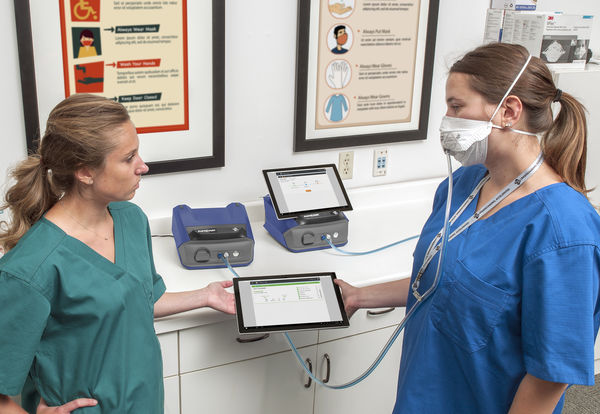Shortages of PPE means that fit test administrators are now testing a wider range of masks and respirators. Varying quality, brands, and types can pose fit testing challenges, particularly when using qualitative fit testing for N95 filtering facepieces.
Qualitative testing methods require a challenge agent such as Saccharin or Bitrex and the wearer’s senses to test respirator fit. With this method, choosing a respirator for a person is often a trial-and-error process, and the result is a subjective pass or fail. For the fit test administrator, it can be difficult to tell if a test failure is due to improper donning and fitting, choosing the wrong respirator, subjective sensing of a challenge agent, or a combination of all three.
Lengthy and repetitive trial-and-error processes waste valuable time and cause frustration. Qualitative fit testing leaves many respirator wearers uncertain about the quality of their respirator fit, leading to a lack of confidence in their respiratory protection. For staff and workforces in the COVID-19 era, confidence in their PPE is essential.
HOW FITCHECK MODE IMPROVES TRAINING AND RESPIRATOR SELECTION FOR STAFF AND TEST ADMINISTRATORS
To increase the confidence staff have in their PPE and help them pass more fit tests, respirator wearers need better training and a suitable respirator chosen for them before testing begins. The PortaCount Fit Tester overcomes the shortcomings of qualitative testing by providing real-time quantitative measurements of respirator fit throughout mask selection, training and testing. The PortaCount Respirator Fit Tester’s unique FitCheck Mode makes it possible.
FitCheck Mode gives users the ability to evaluate a respirator’s fit with real-time measurements, quickly matching masks to even the hardest-to-fit-staff. FitCheck Mode also allows users to see respirator fit change on the screen, through each phase of donning, adjustment, and training. Employees will better understand how to fit respirators to their face, and how proper size and alignment can affect their level of protection. It’s an invaluable lesson for respirator wearers.
For fit test administrators, FitCheck Mode allows them to reject respirators that will not pass a fit test quickly. If a properly donned respirator shows a poor fit, other respirator types and sizes can be tried before spending time on a full fit test.
OPTIMIZING TIME AND RESOURCES WITH QUANTITATIVE FIT TESTING
PortaCount Respirator Fit Testers with FitCheck Mode improve respiratory protection programs in several ways:
- Improved pass rates. Respirator wearers with better training and respirators shown to fit can drastically reduce failure rates.
- Time savings. Reducing the rate of fit test failures saves time significantly.
- Streamlined inventory. Eliminate respirator types from your inventory that consistently fit poorly and focus on those that tend to fit best.
- Build confidence and strong RPPs. By reducing fit test failures and optimizing respirator inventories, respiratory protection programs will become more efficient and effective, and employees will have greater confidence in their personal protective equipment.
